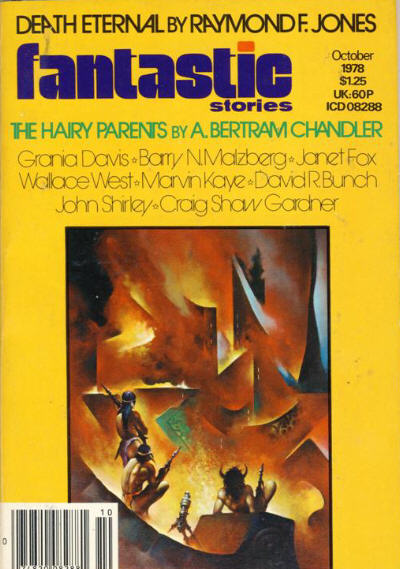Birthday Reviews: Raymond F. Jones’s “Death Eternal”

Raymond F. Jones was born on November 17, 1915 and died on January 24, 1994.
Jones was nominated for a Hugo Award for Best Short Story in 1967 for “Rat Race,” and in 1996 his short story “Correspondence Course” was nominated for a Retro-Hugo. Jones published some poetry under the name David Anderson. Jones is best known for the novel This Island Earth, which was adapted into a film directed by Joseph M. Newman. His 1950 story “Tools of the Trade” may have been the first description of 3D printing.
“Death Eternal” was published in the October 1978 issue of Fantastic, edited by Ted White. The story has never been reprinted and was his final published story.
The lengthy conversation which opens “Eternal Death” is an interesting reversal. Jones has his scientist, Jim Nearing, going into a church to seek proof of the existence of a soul and the possibility to continue his life’s work after his impending death from cancer. Reverend Aaron Marton absolutely refuses to allow for any belief in the afterlife, offering him solace, but noting that the answer Nearing is seeking has been sought for the entire span of mankind’s existence and nobody has come close to uncovering a solution.
Unable to get reassurance from Marton, Nearing attempts to find the soul of a woman who is dying in surgery. His ability to measure the moment the soul leaves her body pushes him to attempt to capture the soul of a condemned prisoner.
When his experiment proves to be a failure, Nearing goes back to Marton’s church, mostly due to a promise he made to Marston’s daughter, Sheila, whom he was attracted to. The two quickly fall in love, but Nearing is too consumed with his own imminent death and the failure of his experiment to be willing to try to make a life with her for the little time he has left, instead deciding that he must continue his experiment using himself as a guinea pig.
Nearing’s character clearly has his own biases. When he proved the soul of the dying woman existed, he viewed it as a triumph for a science scorned by believers, although that is not the attitude Nearing encountered when he spoke to Reverend Marton, but rather it fit into his own narrative. The relationship between Nearing and Sheila is another false step. Jones depicts them with fundamentally different views of the world, with Sheila’s general compassion quickly turning to deep love for Nearing and acceptance of him despite their differences without showing any reason for the change.
Reviewed in its only publication in the magazine Fantastic, edited by Ted White, October 1978.
 Steven H Silver is a sixteen-time Hugo Award nominee and was the publisher of the Hugo-nominated fanzine Argentus as well as the editor and publisher of ISFiC Press for 8 years. He has also edited books for DAW and NESFA Press. He began publishing short fiction in 2008 and his most recently published story is “Webinar: Web Sites” in The Tangled Web. Steven has chaired the first Midwest Construction, Windycon three times, and the SFWA Nebula Conference 6 times, as well as serving as the Event Coordinator for SFWA. He was programming chair for Chicon 2000 and Vice Chair of Chicon 7.
Steven H Silver is a sixteen-time Hugo Award nominee and was the publisher of the Hugo-nominated fanzine Argentus as well as the editor and publisher of ISFiC Press for 8 years. He has also edited books for DAW and NESFA Press. He began publishing short fiction in 2008 and his most recently published story is “Webinar: Web Sites” in The Tangled Web. Steven has chaired the first Midwest Construction, Windycon three times, and the SFWA Nebula Conference 6 times, as well as serving as the Event Coordinator for SFWA. He was programming chair for Chicon 2000 and Vice Chair of Chicon 7.
I’m guessing you meant 1915.
Yes I did. Thank you for pointing the typo out. John, can we send Sven a Noprize?
It’s in the mail!
This exchange made me laugh out loud. Well, a sincere chuckle at least.